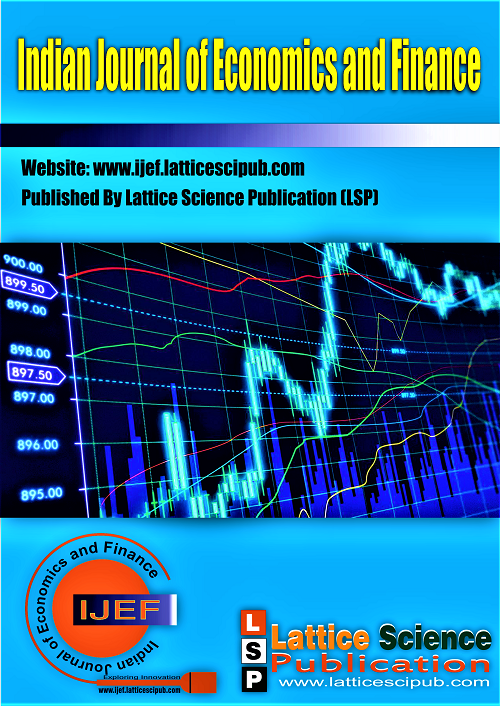Measuring Asymmetric Volatility of Bank Nifty Index using Egarch Model & Obstacle”
Main Article Content
Abstract
The paper examines the significance of volatility models in forecasting future volatility for effective portfolio allocation and risk reduction. It compares the performance of symmetric and asymmetric models in estimating conditional variance, and linear versus non-linear GARCH models. Using secondary data from the National Stock Exchange's Nifty Bank index, the study applies Exponential GARCH (1,1) to measure asymmetric volatility and conducts various tests to confirm the suitability of the data for analysis. The results indicate clustering of volatility in Nifty Bank returns over a four-year period, with the presence of asymmetrical effects and leverage constants. The study concludes that negative information has a greater impact on volatility than positive surprises, and that market fluctuations are inversely related to stock market performance. This research provides valuable insights for portfolio selection, risk management, and asset pricing in the context of increasing volatility across various markets and industries.
Downloads
Article Details

This work is licensed under a Creative Commons Attribution-NonCommercial-NoDerivatives 4.0 International License.
How to Cite
References
Engle, R. F. (1982). Autoregressive conditional heteroscedasticity with estimates of the variance of United Kingdom inflation. Econometrica: Journal of the econometric society, 987-1007.
Bollerslev, T. (1986). Generalized autoregressive conditional heteroskedasticity. Journal of econometrics, 31(3), 307-327.
Bekaert, G., & Wu, G. (2000). Asymmetric volatility and risk in equity markets. The Review of Financial Studies, 13(1), 1–42. https://doi.org/10.1093/rfs/13.1.1.
Caiado, J. (2004). Modelling and forecasting the volatility of the Portuguese stock index PSI-20. Estudos de Gestão, 9(1), 3–22. http://hdl.handle.net/10400.5/9973.
Balaban, E., & Bayar, A. (2005). Stock returns and volatility: empirical evidence from fourteen countries. Applied Economics Letters, 12(10), 603–611. https://doi.org/10.1080/13504850500120607.
Karmakar, M. (2007). Asymmetric volatility and risk-return relationship in the Indian stock market. South Asia Economic Journal, 8(1), 99–116. https://doi.org/10.1177/139156140600800106.
Alberg, D., Shalit, H., &Yosef, R. (2008). Estimating stock market volatility using asymmetric GARCH models. Applied Financial Economics, 18(15), 1201–1208. https://doi.org/ 10.1080/09603100701604225.
Jayasuriya, S., Shambora, W., &Rossiter, R. (2009). Asymmetric volatility in emerging and mature markets. Journal of Emerging Market Finance, 8(1), 25–43. https://doi.org/10.1177/ 097265270900800102.
Su, C. (2010). Application of EGARCH model to estimate financial volatility of daily returns: The empirical case of China. GUPEA, Master thesis submitted.
Srinivasan, P., & Ibrahim, P. (2010). Forecasting stock market volatility of BSE-30 index using GARCH models. Asia Pacific Business Review, 6(3), 47–60. https://doi.org/10.1177/ 097324701000600304.
Baur, D. G. (2012). Asymmetric volatility in the gold market. The Journal of Alternative Investments, 14(4), 26–38. https://doi. org/10.3905/jai.2012.14.4.026.
Kristoufek, L. (2014). Leverage effect in energy futures. Energy Economics, 45, 1–9. http://dx.doi.org/10.1016/j.eneco.2014.06.009.
Lama, A., Jha, G. K., Paul, R. K., & Gurung, B. (2015). Modelling and forecasting of price volatility: An application of GARCH and EGARCH models. Agricultural Economics Research Review, 28(347-2016-17165), 73–82. https://doi. org/10.5958/0974-0279.2015.00005.1.
Ndwiga, D., &Muriu, P. W. (2016). Stock Returns and Volatility İn An Emerging Equity Market. Evidence from Kenya. European Scientific Journal, 12(4), 79. https://doi.org/10.19044/esj.2016. v12n4p79.
Vasudevan, R. D., & Vetrivel, S. C. (2016). Forecasting stock market volatility using GARCH models: Evidence from the Indian stock market. Asian Journal of Research in Social Sciences and Humanities, 6(8), 1565-1574.
Sharma, P. (2015). Forecasting stock index volatility with GARCH models: international evidence. Studies in Economics and Finance. https://doi.org/10.1108/SEF-11-2014-0212.
Raja Babu, P., Kumar, S. R., &Naganjaneyulu, A. V. (2020). Modeling Asymmetric Volatility: Evidence from India. Journal of Critical Reviews, 7(9), 845–850. https://doi.org/10.31838/jcr.07.09.158.
Samineni, R. K., Puppala, R. B., Muthangi, R., &Kulapathi, S. (2020). Expiration-Day Effects on Index Futures: Evidence from Indian Market. Journal of Asian Finance, Economics and Business, 7(11), 95–100. https://doi:10.13106/jafeb.2020.vol7.no11.095.
Raju, V. V. R. (2022). Stock Price Volatility Modeling and Forecasting Of Nifty 50 Companies in India. IJMER, 11(2) 1, 149-161.
Pulatovich, E. M. (2019). Impact of Financial Sustainability on Enterprise Value Expansion. In International Journal of Engineering and Advanced Technology (Vol. 9, Issue 1, pp. 4640–4645). https://doi.org/10.35940/ijeat.a2926.109119
Mukherjee, P., Palan, P., & Bonde, M. V. (2021). Using Machine Learning and Artificial Intelligence Principles to Implement a Wealth Management System. In International Journal of Soft Computing and Engineering (Vol. 10, Issue 5, pp. 26–31). https://doi.org/10.35940/ijsce.f3500.0510521
Jenkins, J., & Ford, Dr. J. (2022). Event Study Are Effie Award Winning Campaigns Associated with Improved Stock Market Performance. In International Journal of Management and Humanities (Vol. 9, Issue 4, pp. 1–9). https://doi.org/10.35940/ijmh.d1542.129422
Dutta, S., & Bandyopadhyay*, S. K. (2020). Price Prediction of Stock Market- An Empirical Research. In International Journal of Recent Technology and Engineering (IJRTE) (Vol. 9, Issue 1, pp. 1015–1021). https://doi.org/10.35940/ijrte.a2083.059120
Banerjee, Prof. S., & Agarwalla, V. (2022). Did Lockdown Affect Stock Returns of Airline Sector in India. In Indian Journal of Economics and Finance (Vol. 2, Issue 2, pp. 1–8). https://doi.org/10.54105/ijef.d2516.111422





